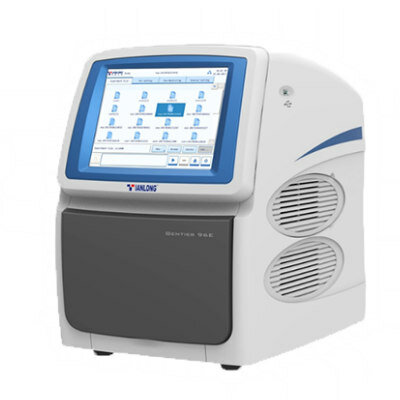Study Reaffirms HbA1c Analyzer Meets Performance Standards
|
By LabMedica International staff writers Posted on 10 Mar 2017 |

Image: The Quo-Test analyzer (Photo courtesy of EKF Diagnostics).
In a newly published paper, a point-of-care (POC) hemoglobin A1c (HbA1c) analyzer has again been confirmed to meet the performance criteria of the International Federation of Clinical Chemistry and Laboratory Medicine (IFCC).
Using sigma-metrics data modeling, scientists from the European Reference Laboratory for Glycohemoglobin demonstrated that the Quo-Test HbA1c analyzer from EKF Diagnostics easily met IFCC accepted quality targets of >2 sigma at 10% total allowable error (TAE) at 48 mmol/mol HbA1c. This is essential for effective monitoring of glycemic control in diabetes patients.
Under strict evaluation conditions, Quo-Test was not only shown to perform extremely well against routine laboratory analyzers (certified as secondary reference measurement procedures (SRMPs)), but also when compared to 6 other POC HbA1c analyzers. The authors explained that in the laboratory, sigma-metrics is a quality management strategy that provides a universal benchmark for analytical performance - effectively placing all analyzers on a level playing field. Using sigma-metrics, analytical characteristics (bias and imprecision) are placed in the form of TAE within a framework of clinical requirements. An IFCC Task Force in 2015 advocated the use of sigma-metrics quality targets for HbA1c to standardize analytical quality at a global level.
This latest study follows the release of critical evaluation data by the European Reference Laboratory for Glycohemoglobin published in a white paper in 2016, which also demonstrated Quo-Test’s excellent performance. In the white paper Quo-Test’s performance in sigma-metrics was also very good. Notably, within the 2016 evaluation study, the boronate affinity fluorescence quenching technology employed by Quo-Test was demonstrated to maintain results consistency due to its ability to minimize the effects of hemoglobin variants. This compared well with laboratory-based HPLC systems. Quo-Test showed no interference of common Hb-variants.
“We are extremely confident that our Quo-Test is one of the most accurate, easy-to-use and reliable HbA1c POC analyzers available, which is also unaffected by most hemoglobin variants,”said Gavin Jones, Global Diabetes Product Manager, EKF Diagnostics. CE-marked for the monitoring of HbA1c in diabetes patients, Quo-Test is automated and specifically designed for use in POC settings such as diabetes clinics and doctors’ surgeries, measuring HbA1c from a 4 µL sample taken from a finger prick or venous whole blood. Results are available in 4 minutes within a measuring range of 4-15% A1c DCCT, and precision performance with a CV of 2.2% at 6.6% DCCT has been demonstrated.
The study, by Lenters-Westra E & English E, was published in the March 2017 issue of the journal Clinics in Laboratory Medicine.
Using sigma-metrics data modeling, scientists from the European Reference Laboratory for Glycohemoglobin demonstrated that the Quo-Test HbA1c analyzer from EKF Diagnostics easily met IFCC accepted quality targets of >2 sigma at 10% total allowable error (TAE) at 48 mmol/mol HbA1c. This is essential for effective monitoring of glycemic control in diabetes patients.
Under strict evaluation conditions, Quo-Test was not only shown to perform extremely well against routine laboratory analyzers (certified as secondary reference measurement procedures (SRMPs)), but also when compared to 6 other POC HbA1c analyzers. The authors explained that in the laboratory, sigma-metrics is a quality management strategy that provides a universal benchmark for analytical performance - effectively placing all analyzers on a level playing field. Using sigma-metrics, analytical characteristics (bias and imprecision) are placed in the form of TAE within a framework of clinical requirements. An IFCC Task Force in 2015 advocated the use of sigma-metrics quality targets for HbA1c to standardize analytical quality at a global level.
This latest study follows the release of critical evaluation data by the European Reference Laboratory for Glycohemoglobin published in a white paper in 2016, which also demonstrated Quo-Test’s excellent performance. In the white paper Quo-Test’s performance in sigma-metrics was also very good. Notably, within the 2016 evaluation study, the boronate affinity fluorescence quenching technology employed by Quo-Test was demonstrated to maintain results consistency due to its ability to minimize the effects of hemoglobin variants. This compared well with laboratory-based HPLC systems. Quo-Test showed no interference of common Hb-variants.
“We are extremely confident that our Quo-Test is one of the most accurate, easy-to-use and reliable HbA1c POC analyzers available, which is also unaffected by most hemoglobin variants,”said Gavin Jones, Global Diabetes Product Manager, EKF Diagnostics. CE-marked for the monitoring of HbA1c in diabetes patients, Quo-Test is automated and specifically designed for use in POC settings such as diabetes clinics and doctors’ surgeries, measuring HbA1c from a 4 µL sample taken from a finger prick or venous whole blood. Results are available in 4 minutes within a measuring range of 4-15% A1c DCCT, and precision performance with a CV of 2.2% at 6.6% DCCT has been demonstrated.
The study, by Lenters-Westra E & English E, was published in the March 2017 issue of the journal Clinics in Laboratory Medicine.
Latest Clinical Chem. News
- 3D Printed Point-Of-Care Mass Spectrometer Outperforms State-Of-The-Art Models
- POC Biomedical Test Spins Water Droplet Using Sound Waves for Cancer Detection
- Highly Reliable Cell-Based Assay Enables Accurate Diagnosis of Endocrine Diseases
- New Blood Testing Method Detects Potent Opioids in Under Three Minutes
- Wireless Hepatitis B Test Kit Completes Screening and Data Collection in One Step
- Pain-Free, Low-Cost, Sensitive, Radiation-Free Device Detects Breast Cancer in Urine
- Spit Test Detects Breast Cancer in Five Seconds
- Electrochemical Sensors with Next-Generation Coating Advances Precision Diagnostics at POC
- First-Of-Its-Kind Handheld Device Accurately Detects Fentanyl in Urine within Seconds
- New Fluorescent Sensor Array Lights up Alzheimer’s-Related Proteins for Earlier Detection
- Automated Mass Spectrometry-Based Clinical Analyzer Could Transform Lab Testing
- Highly Sensitive pH Sensor to Aid Detection of Cancers and Vector-Borne Viruses
- Non-Invasive Sensor Monitors Changes in Saliva Compositions to Rapidly Diagnose Diabetes
- Breakthrough Immunoassays to Aid in Risk Assessment of Preeclampsia
- Urine Test for Monitoring Changes in Kidney Health Markers Can Predict New-Onset Heart Failure
- AACC Releases Comprehensive Diabetes Testing Guidelines
Channels
Molecular Diagnostics
view channel
Unique Autoantibody Signature to Help Diagnose Multiple Sclerosis Years before Symptom Onset
Autoimmune diseases such as multiple sclerosis (MS) are thought to occur partly due to unusual immune responses to common infections. Early MS symptoms, including dizziness, spasms, and fatigue, often... Read more
Blood Test Could Detect HPV-Associated Cancers 10 Years before Clinical Diagnosis
Human papilloma virus (HPV) is known to cause various cancers, including those of the genitals, anus, mouth, throat, and cervix. HPV-associated oropharyngeal cancer (HPV+OPSCC) is the most common HPV-associated... Read moreHematology
view channel
Next Generation Instrument Screens for Hemoglobin Disorders in Newborns
Hemoglobinopathies, the most widespread inherited conditions globally, affect about 7% of the population as carriers, with 2.7% of newborns being born with these conditions. The spectrum of clinical manifestations... Read more
First 4-in-1 Nucleic Acid Test for Arbovirus Screening to Reduce Risk of Transfusion-Transmitted Infections
Arboviruses represent an emerging global health threat, exacerbated by climate change and increased international travel that is facilitating their spread across new regions. Chikungunya, dengue, West... Read more
POC Finger-Prick Blood Test Determines Risk of Neutropenic Sepsis in Patients Undergoing Chemotherapy
Neutropenia, a decrease in neutrophils (a type of white blood cell crucial for fighting infections), is a frequent side effect of certain cancer treatments. This condition elevates the risk of infections,... Read more
First Affordable and Rapid Test for Beta Thalassemia Demonstrates 99% Diagnostic Accuracy
Hemoglobin disorders rank as some of the most prevalent monogenic diseases globally. Among various hemoglobin disorders, beta thalassemia, a hereditary blood disorder, affects about 1.5% of the world's... Read moreImmunology
view channel
Diagnostic Blood Test for Cellular Rejection after Organ Transplant Could Replace Surgical Biopsies
Transplanted organs constantly face the risk of being rejected by the recipient's immune system which differentiates self from non-self using T cells and B cells. T cells are commonly associated with acute... Read more
AI Tool Precisely Matches Cancer Drugs to Patients Using Information from Each Tumor Cell
Current strategies for matching cancer patients with specific treatments often depend on bulk sequencing of tumor DNA and RNA, which provides an average profile from all cells within a tumor sample.... Read more
Genetic Testing Combined With Personalized Drug Screening On Tumor Samples to Revolutionize Cancer Treatment
Cancer treatment typically adheres to a standard of care—established, statistically validated regimens that are effective for the majority of patients. However, the disease’s inherent variability means... Read moreMicrobiology
view channel
Mouth Bacteria Test Could Predict Colon Cancer Progression
Colon cancer, a relatively common but challenging disease to diagnose, requires confirmation through a colonoscopy or surgery. Recently, there has been a worrying increase in colon cancer rates among younger... Read more.jpg)
Unique Metabolic Signature Could Enable Sepsis Diagnosis within One Hour of Blood Collection
Sepsis is a life-threatening condition triggered by an extreme response of the body to an infection. It requires immediate medical intervention to prevent potential death or lasting damage.... Read morePathology
view channel
Spatial Tissue Analysis Identifies Patterns Associated With Ovarian Cancer Relapse
High-grade serous ovarian carcinoma is the most lethal type of ovarian cancer, and it poses significant detection challenges. Typically, patients initially respond to surgery and chemotherapy, but the... Read more.jpg)
Unique Hand-Warming Technology Supports High-Quality Fingertip Blood Sample Collection
Warming the hand is an effective way to facilitate blood collection from a fingertip, yet off-the-shelf solutions often do not fulfill laboratory requirements. Now, a unique hand-warming technology has... Read moreTechnology
view channel
New Diagnostic System Achieves PCR Testing Accuracy
While PCR tests are the gold standard of accuracy for virology testing, they come with limitations such as complexity, the need for skilled lab operators, and longer result times. They also require complex... Read more
DNA Biosensor Enables Early Diagnosis of Cervical Cancer
Molybdenum disulfide (MoS2), recognized for its potential to form two-dimensional nanosheets like graphene, is a material that's increasingly catching the eye of the scientific community.... Read more
Self-Heating Microfluidic Devices Can Detect Diseases in Tiny Blood or Fluid Samples
Microfluidics, which are miniature devices that control the flow of liquids and facilitate chemical reactions, play a key role in disease detection from small samples of blood or other fluids.... Read more
Breakthrough in Diagnostic Technology Could Make On-The-Spot Testing Widely Accessible
Home testing gained significant importance during the COVID-19 pandemic, yet the availability of rapid tests is limited, and most of them can only drive one liquid across the strip, leading to continued... Read moreIndustry
view channel
ECCMID Congress Name Changes to ESCMID Global
Over the last few years, the European Society of Clinical Microbiology and Infectious Diseases (ESCMID, Basel, Switzerland) has evolved remarkably. The society is now stronger and broader than ever before... Read more
Bosch and Randox Partner to Make Strategic Investment in Vivalytic Analysis Platform
Given the presence of so many diseases, determining whether a patient is presenting the symptoms of a simple cold, the flu, or something as severe as life-threatening meningitis is usually only possible... Read more
Siemens to Close Fast Track Diagnostics Business
Siemens Healthineers (Erlangen, Germany) has announced its intention to close its Fast Track Diagnostics unit, a small collection of polymerase chain reaction (PCR) testing products that is part of the... Read more
















